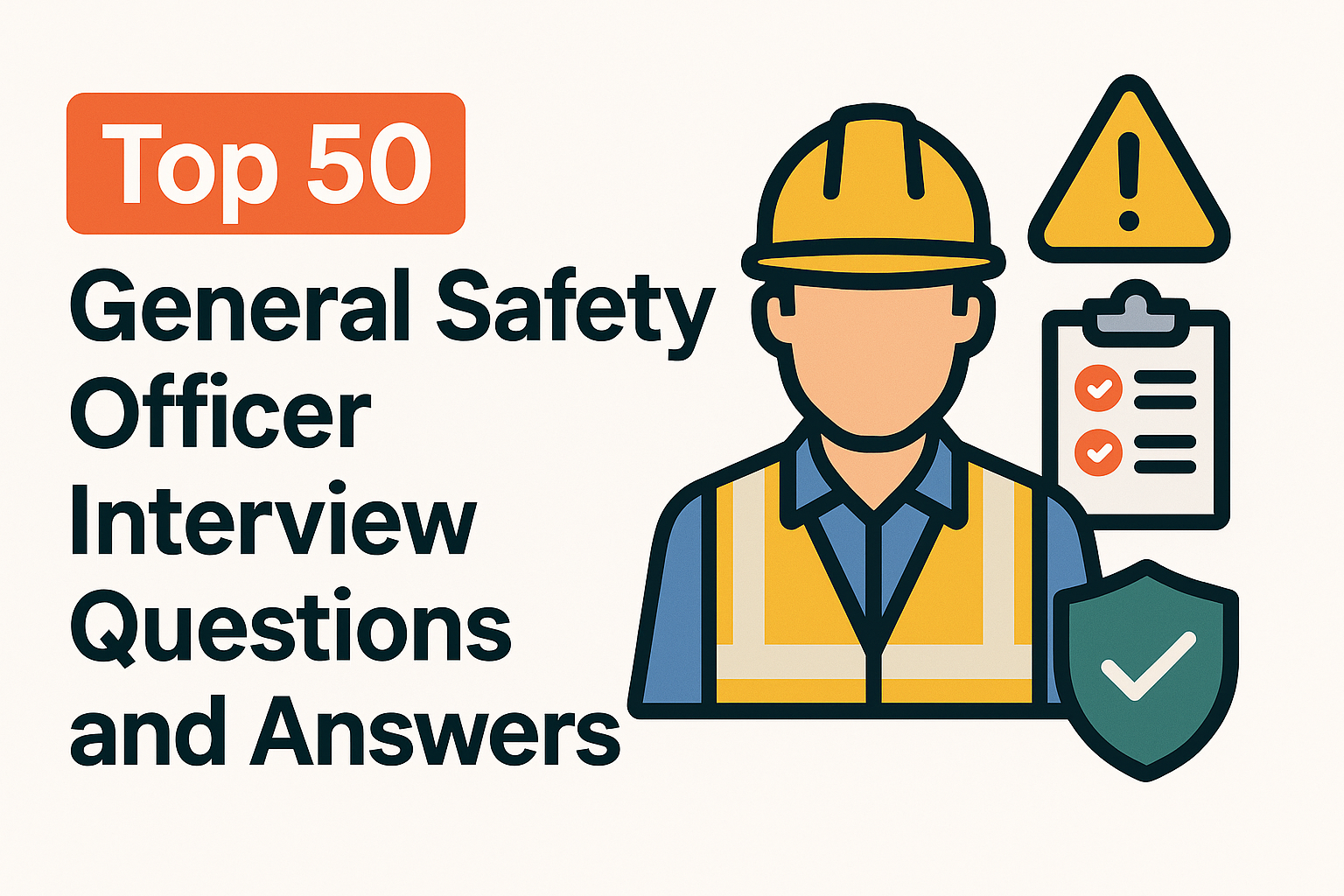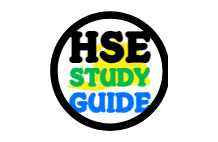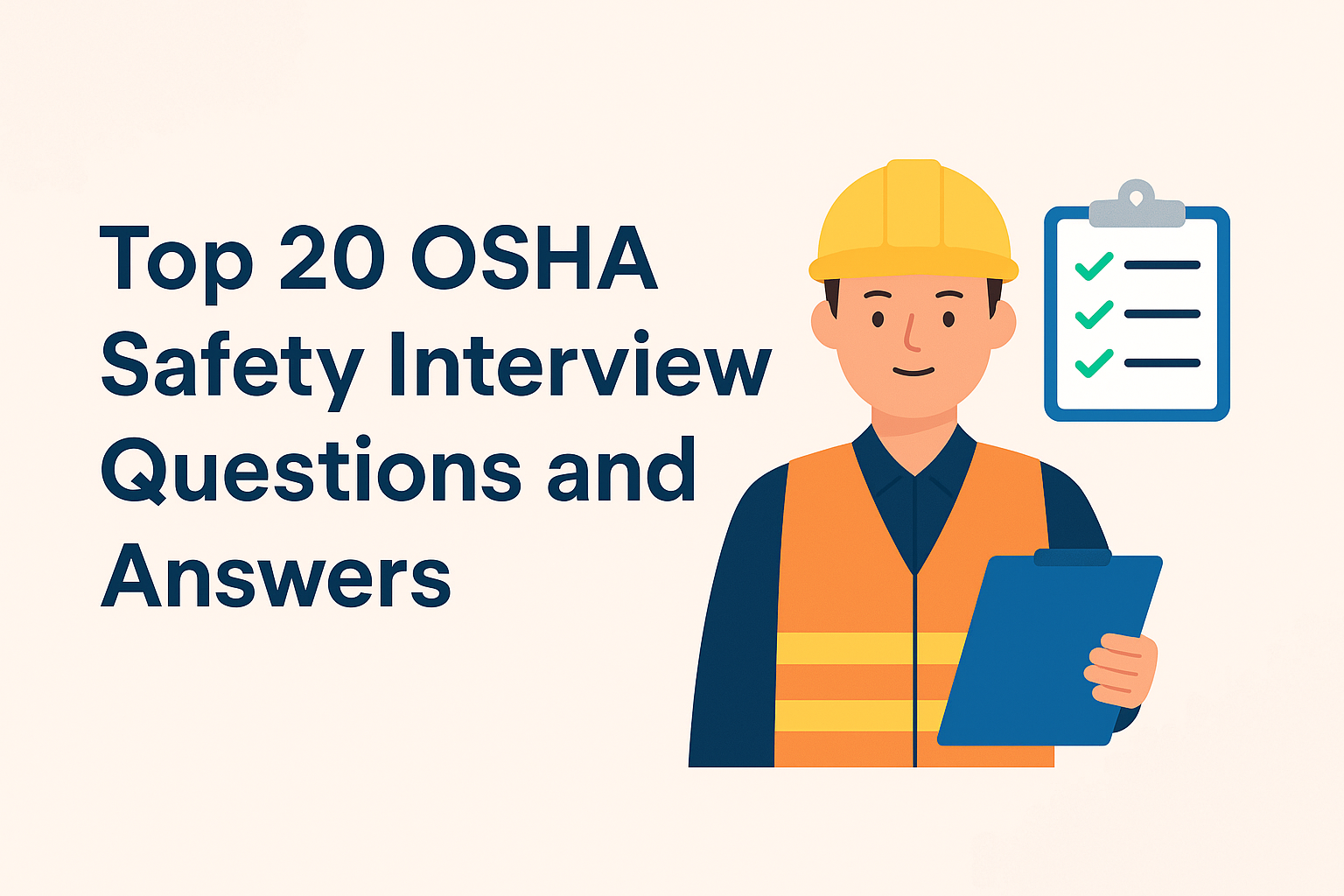
Top 50 General Safety Officer Interview Questions and Answers – Complete Guide
If you’re preparing for an upcoming safety officer job interview, it’s important to anticipate the most frequently asked general safety officer interview questions. Whether you’re entering the construction industry, manufacturing, oil & gas, or power plants, this list will help you succeed in technical and HR rounds.
This guide is divided into:
- Basic and introductory safety questions
- Technical safety officer questions
- Scenario-based safety interview questions
- Regulatory and compliance questions
- Behavioral and leadership questions
📘 Basic General Safety Officer Interview Questions
1. What is the role of a safety officer?
Answer:
A safety officer ensures that all workplace activities comply with safety regulations, risk assessments, and standard operating procedures. The goal is to prevent accidents, promote a safety culture, and ensure legal compliance.
2. What is the definition of safety?
Answer:
Safety is the condition of being protected from harm or other non-desirable outcomes. In the workplace, safety means controlling hazards to achieve an acceptable level of risk.
3. What is a hazard?
Answer:
A hazard is any source that has the potential to cause harm—such as chemicals, machinery, electricity, or unsafe behaviors.
4. What is the difference between hazard and risk?
Answer:
- Hazard: Potential to cause harm
- Risk: Likelihood that harm will occur from a hazard and the severity of the outcome
5. What are the responsibilities of a safety officer?
Answer:
- Conduct inspections and audits
- Prepare HIRA and JSA
- Deliver safety induction and toolbox talks
- Enforce use of PPE
- Monitor compliance
- Investigate incidents and recommend corrective actions
🛠️ Technical Safety Officer Interview Questions
6. What is PPE and give examples?
Answer:
PPE stands for Personal Protective Equipment. Examples include safety helmets, gloves, safety goggles, ear protection, and safety shoes.
7. Explain the hierarchy of controls.
Answer:
- Elimination
- Substitution
- Engineering Controls
- Administrative Controls
- PPE
This method prioritizes hazard control from most effective to least effective.
8. What is HIRA?
Answer:
Hazard Identification and Risk Assessment is a proactive process to identify hazards and evaluate their risk in order to apply control measures.
9. What is a Permit to Work system?
Answer:
A Permit to Work (PTW) is a formal written system used to control certain types of high-risk work, such as hot work, electrical work, or confined space entry.
10. What is a Toolbox Talk?
Answer:
A short, focused safety briefing conducted before starting work to discuss specific job-related hazards and safety procedures.
11. How do you calculate risk rating?
Answer:
Risk = Likelihood × Severity
Used in risk matrices to prioritize actions.
12. What is a confined space?
Answer:
An area not designed for continuous occupancy, with limited entry/exit, and potential hazards such as toxic gases or low oxygen levels.
13. What is LOTO?
Answer:
LOTO stands for Lockout/Tagout – a system to prevent accidental startup of equipment during maintenance.
14. What are the different types of fire extinguishers?
Answer:
- Class A: For paper, wood (water)
- Class B: For flammable liquids (foam, CO₂)
- Class C: For electrical fires (CO₂, dry powder)
- Class D: For combustible metals
- Class K: For kitchen fires (wet chemical)
🔍 Scenario-Based Safety Interview Questions
15. What would you do if you saw an unsafe act on site?
Answer:
Immediately stop the unsafe act, educate the worker, correct the condition, and document the incident for follow-up.
16. How would you handle a worker refusing to wear PPE?
Answer:
Counsel the worker, explain the risks, escalate to supervision if needed, and document the refusal.
17. A confined space entry is about to begin, but the gas detector is missing. What do you do?
Answer:
Do not permit entry. Stop the job until a gas detector is available and atmospheric testing is done. Never compromise safety procedures.
18. You witness a near miss. What steps do you take?
Answer:
Secure the area, report the near miss, investigate root causes, and implement corrective/preventive actions.
19. What actions do you take during a fire emergency?
Answer:
Raise the alarm, ensure safe evacuation, activate emergency response procedures, and report to incident commander.
20. How do you ensure the safety of new workers on site?
Answer:
- Provide safety induction
- Assign a mentor or buddy
- Monitor closely during initial tasks
- Conduct follow-up toolbox talks
📊 Compliance and Regulatory Interview Questions
21. What are OSHA and ISO 45001?
Answer:
- OSHA: U.S. safety regulations
- ISO 45001: International Occupational Health and Safety Management System standard
22. What is the General Duty Clause under OSHA?
Answer:
Employers must provide a workplace free from recognized hazards that may cause death or serious harm.
23. What are legal duties of an employer and employee?
Answer:
- Employer: Provide safe workplace, training, and equipment
- Employee: Follow instructions, wear PPE, report hazards
24. What is an incident vs. accident?
Answer:
- Incident: Any event with potential for loss
- Accident: An incident that results in injury, damage, or loss
25. How do you investigate an incident?
Answer:
- Preserve the scene
- Collect witness statements
- Analyze root cause
- Implement corrective actions
- Document the findings
🤝 Behavioral and Leadership-Based Safety Questions
26. How do you promote safety culture?
Answer:
Lead by example, communicate frequently, involve employees in safety decisions, and reward safe behaviors.
27. Have you ever faced resistance to a safety policy? What did you do?
Answer:
Yes, I addressed the concerns with communication, explained the rationale, and sought leadership support for reinforcement.
28. How do you keep yourself updated with safety regulations?
Answer:
Attend webinars, subscribe to HSE newsletters, follow OSHA and NEBOSH, and engage in continuous training.
29. How do you prioritize tasks during an emergency?
Answer:
Focus on life safety first, then containment of hazard, followed by communication, coordination, and documentation.
30. What’s the most important trait for a safety officer?
Answer:
Consistency and integrity—ensuring the same safety rules apply to everyone, every time.
🧩 More Technical Questions
31. What is an MSDS/SDS?
Answer:
MSDS stands for Material Safety Data Sheet (now commonly known as SDS – Safety Data Sheet). It provides detailed information on:
- The chemical’s properties
- Health hazards
- Safe handling and storage
- Emergency and first-aid procedures
It is mandatory under OSHA’s Hazard Communication Standard (HCS).
32. What are leading and lagging safety indicators?
Answer:
- Leading Indicators are proactive measures, such as:
- Number of safety training sessions
- Near-miss reports
- Safety audits completed
- Lagging Indicators are reactive measures, such as:
- Number of injuries or incidents
- Lost time injury frequency rate (LTIFR)
33. What’s the use of barricading?
Answer:
Barricading is used to restrict access to hazardous areas, prevent unauthorized entry, and guide people safely through job sites. Types include caution tape, hard barricades, and warning signage.
34. Explain the meaning of “As Low As Reasonably Practicable (ALARP).”
Answer:
ALARP means that risks should be reduced to the lowest possible level where the cost, effort, or time is not grossly disproportionate to the benefit gained. It’s a balance between risk reduction and feasibility.
35. What is safety audit vs. safety inspection?
Answer:
- Safety Audit: A detailed, systematic evaluation of an organization’s safety management system. Usually done periodically.
- Safety Inspection: Routine checks to identify hazards and unsafe practices on-site. More frequent and less formal.
36. What is emergency preparedness?
Answer:
Emergency preparedness involves planning and preparing to respond effectively to unexpected events such as fires, explosions, natural disasters, or chemical leaks. It includes:
- Emergency response plans (ERP)
- Drills and training
- Emergency equipment readiness
37. What is work at height? Define safe practices.
Answer:
Work at height is any work done at a place where a person could fall and get injured.
Safe practices include:
- Use of full body harnesses
- Guardrails and scaffolds
- Ladder safety
- Fall arrest systems
- Permit-to-work system
38. What are types of safety signs?
Answer:
- Mandatory Signs (Blue): PPE required
- Warning Signs (Yellow/Amber): Hazard ahead
- Prohibition Signs (Red): Actions not allowed
- Emergency Signs (Green): Exits, first aid
- Fire Equipment Signs (Red): Location of extinguishers, alarms
39. What is behavioral-based safety (BBS)?
Answer:
BBS is a proactive safety approach that focuses on workers’ behaviors rather than conditions. It involves:
- Observation of behavior
- Feedback and positive reinforcement
- Encouraging safe habits
- Reducing unsafe acts before they lead to incidents
40. What are the elements of a safety management system?
Answer:
According to ISO 45001 or ILO-OSH, elements include:
- Safety Policy
- Risk Assessment and Planning
- Organizational Structure
- Operational Control
- Training and Communication
- Performance Measurement
- Audit and Review
- Continual Improvement
41. How do you manage contractors’ safety?
Answer:
- Conduct pre-job safety inductions
- Verify certifications and training
- Ensure adherence to site safety procedures
- Monitor work through regular audits
- Include contractors in toolbox talks and safety meetings
42. Explain near-miss reporting system.
Answer:
A near miss is an unplanned event that did not result in injury but had the potential to do so.
Reporting helps:
- Identify unsafe conditions
- Take corrective actions
- Improve workplace safety culture
43. What is a safety committee?
Answer:
A group composed of workers and management that:
- Discuss safety issues
- Review incident reports
- Make recommendations
- Promote safety awareness
The goal is to foster collaboration in achieving safety objectives.
44. What are the KPIs you use to monitor safety performance?
Answer:
- Total Recordable Incident Rate (TRIR)
- Lost Time Injury Frequency Rate (LTIFR)
- Number of Near Misses
- Toolbox talks conducted
- Training hours per employee
- Compliance rate from audits
45. Explain your role in incident investigation.
Answer:
- Secure the scene
- Collect evidence and witness statements
- Identify root causes (e.g., using 5 Whys or Fishbone Diagram)
- Recommend corrective and preventive actions
- Document and share findings with stakeholders
46. What is thermal stress and how to control it?
Answer:
Thermal stress results from exposure to extreme temperatures, especially heat.
Controls include:
- Providing shaded rest areas
- Hydration breaks
- Job rotation
- PPE (cooling vests, breathable clothing)
47. What is ergonomics in workplace safety?
Answer:
Ergonomics is the science of designing jobs, tools, and workstations to fit the worker’s capabilities. It aims to prevent musculoskeletal disorders by minimizing strain, awkward postures, and repetitive movements.
48. Describe a situation where your safety intervention prevented a serious accident.
Answer:
(Example) During a routine inspection, I noticed a scaffold without toe boards above a walkway. I immediately stopped the work, corrected the setup, and later during a wind gust, tools fell but were contained. Had I not intervened, someone could have been seriously injured.
49. What documents must be maintained on a construction site for safety compliance?
Answer:
- HIRA and JSA reports
- Permit to Work records
- Incident reports
- Inspection checklists
- Safety training attendance sheets
- Toolbox talk logs
- SDS for hazardous substances
- Emergency contact list and ERP
50. What challenges have you faced as a safety officer, and how did you overcome them?
Answer:
One major challenge was resistance to PPE usage. I overcame this by:
- Conducting awareness training
- Showing real-life incident examples
- Gaining management support
- Recognizing safe behavior publicly
This improved PPE compliance significantly.
🎯 Final Tips to Crack General Safety Officer Interviews
- ✅ Use examples from past experience
- ✅ Understand the job site and industry requirements
- ✅ Speak confidently using safety terms and regulations
- ✅ Stay updated with OSHA/NEBOSH/ISO guidelines
- ✅ Demonstrate leadership, teamwork, and calmness under pressure
📚 Additional Resources
📝 Conclusion
These Top 50 General Safety Officer Interview Questions are designed to help you succeed in interviews across industries. Being well-prepared with practical examples and regulatory knowledge will help you stand out as a competent safety professional.
Top 25 OSHA Safety Interview Questions and Answers – Ultimate Guide for HSE Jobs
Top 20 NEBOSH Safety Interview Questions and Answers – A Complete Guide
ISO 45001 MCQs for Beginners – Start Your OH&S Journey
ISO 45001 Internal Auditor Exam – Sample MCQs for Preparation
























